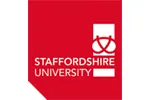We're moving! This site will be relocating to goingto.university in 2026. Please update your bookmarks to the new address.


| The award | How you will study | Study duration | Course start | Domestic course fees | International course fees |
|---|---|---|---|---|---|
| MA | Part-time | 36 months | September | GBP 2040 | - |
MA Ceramic Design is recognised worldwide as one of the leading postgraduate programmes in ceramic design for small and mass manufacture. Taught in Stoke-on-Trent, the home of UK ceramics for over two centuries in the Potteries, this long-established course consistently produces career-ready graduates that are in demand by leading ceramic companies both in the UK and overseas. With world-famous ceramic manufacturers quite literally on the doorstep, Stoke-on-Trent provides a unique venue for the study of ceramic design.
This course provides a design-led creative experience of ceramics within a broad subject context. Designing through intelligent making allows you to access ideas through a unique material. The deep knowledge of one material helps you to appreciate the opportunities in ceramics but also its translation into other materials and professional opportunities. Whether your personal aspirations are embedded in 2D surface and pattern, and or 3D shape, form and function.
The relationship between the course and the global ceramic industry is mutually beneficial and is primarily responsible for the unique character and international reputation of the course. The strength of this award lies in the accumulated wealth of specialist knowledge and practical skills, which are the essential tools of the ceramics designer; and in the good working practices developed over many years. In the close working relationship with industry, and in the clarity of purpose that ensures academic coherence, and the credibility of the award.
Students are encouraged to pursue new and innovative ideas, redefining established ceramic craft and ceramic design market opportunities. These ideas may now be less wedded to the immediate perceived needs of the mass manufacturing industry and for the mass market. As a consequence encouraging students to take a wider perhaps more entrepreneurial, enterprising standpoint - working as designer-producers for example, engaging with small to medium sized factories in developing aspirational products of contemporary relevance with 'added value' aimed potentially at new and different niche markets.
The MA Ceramic Design course has in recent years provided the creative genesis for The New English ceramic design brand and the University's unique Flux, blue and white fine bone china collection.
Course Fees and Finance
The expected study pattern on this programme enables you to complete modules totalling 60 credits in your first year of study and the other 120 credits, split equally over your second and third year of study. If you follow this pattern of study you will pay a fee of £2,040 for your first year in 2017/18. The fee for your second and third year of study will be broadly the same, except that an inflationary uplift may apply.* You will be invoiced for the modules that you register for each year, so if your study pattern is different from the expected pattern, you will pay more or less each year accordingly.
If you would like to know more about the fees listed and what this means to you then please get in touch with our Enquiries Team.
* The fees listed are for the 2017/18 academic year only. Any subsequent years may be subject to an inflationary uplift.
Alumni Discount: If you have previously completed an undergraduate degree with us, you may be entitled to 15% off your course fee for any subsequent postgraduate taught course. For further information please contact Graduate Relations.'
Postgraduate Loans:
Providing you are studying towards a full Masters qualification you may be able to apply for a loan of up to £10,280 to help with tuition fees, maintenance and other associated costs. You won't have to start repaying the loan until you are earning more than (currently) £21,000 per year.
Course content
Semester 1
Tools and Techniques aims to establish a common methodology and practice of ceramic design. This is introduced through a prescribed project which will serve also to encourage the acquisition of technical and practical knowledge, and seek to develop skills from 'traditional' craft to new digital technologies. The emphasis will be on the development and presentation of design ideas related to typical issues addressing both two dimensional surface and three dimensional shape design.
Collaborative Project introduces the activity of working with external clients. This practice is fundamental to the core aims of the programme. This would commonly be prescribed by a major ceramic manufacturer or a key retailer for example.
Semester 2
Ceramic Design, Professional Pathways requires students to negotiate with course staff their own programme of design research and practice. This will build upon the foundation of semester 1 and encourage students to define their personal and professional objectives and aspirations. Running concurrently will be a contextual/business studies module, students will begin to understand the relevance and integration of theoretical and academic studies and design practice.
Creativity & Innovation encourages students to build upon the research skills established but to consider a variety of business, management and enterprise activities within which their creative design practice may logically locate. This will provide students with the appropriate knowledge, acumen and enterprising skills related to their proposed career in professional practice..
Semester 3
The Masters Project synthesises your acquired knowledge and skills gained through a significant body of design work. Through this you will prove your ability to choose, plan, manage, implement and contextualise a particular project in the field of ceramic design.
Graduate destinations
Many of our Ceramic Design graduates now work as designers or senior managers and creative directors within the ceramics and related creative industries. Some have set up in business as designer-producers or as freelance design consultants. And others have become retail developers, stylists, buyers, trend forecasters, lecturers and teachers.
MA Ceramic Design Graduate employment 1991 - 2015
Graduates in directorate positions
Graduates in management positions
In making an application to us, we would expect you to have a genuine interest in ceramic DESIGN - The course is NOT about ceramic Art or Sculpture. For you to be able to execute your own ideas whilst on the course, You would be expected to demonstrate :
Below are some suggested courses at other providers that you may also be interested in:
Graduate Diploma of Engineering (Electrical Systems) Graduate Diploma
Engineering Institute of Technology
Find out moreBrief Evidence-Based Psychological Treatments for the Education Setting (CYP IAPT Pathway) PG Dip, Graduate Diploma
University of Reading
Find out morePsychology MRes, MRes, Graduate Diploma, Graduate Diploma
University of Greater Manchester
Find out moreAcademic English and Study Skills Preparation programmes Master's Qualifying Programme
University of Nottingham
Find out moreIf you do not meet the entry requirements for this course then consider one of these postgraduate preparation courses from another institution:
Graduate Diploma of Engineering (Electrical Systems)
Engineering Institute of Technology
Find out moreThere are 163 other courses listed from University of Staffordshire. A selection of these are displayed below:
Advanced Forensic Practice (Custody Health Professional) MSc
University of Staffordshire
Find out moreAdvanced Forensic Practice (Custody Health Professional) PG Cert
University of Staffordshire
Find out moreAdvanced Forensic Practice (Custody Health Professional) PG Dip
University of Staffordshire
Find out moreAdvanced Forensic Practice (Sexual Assault And Custody Health Professional) MSc
University of Staffordshire
Find out moreAdvanced Forensic Practice (Sexual Assault And Custody Health Professional) PG Dip
University of Staffordshire
Find out moreJoin the StudyLink email list and never miss a chance to turn your study abroad dreams into reality!

Find out more about studying in the United Kingdom